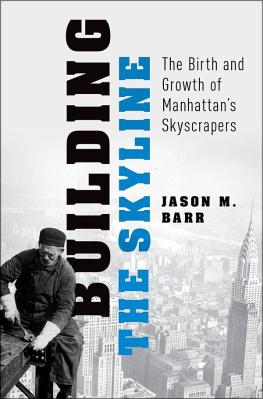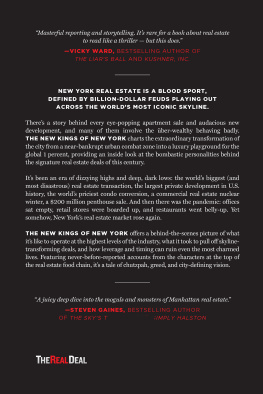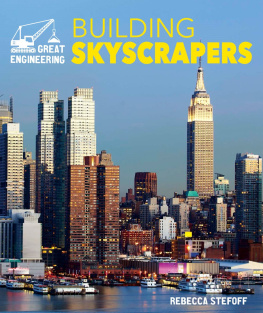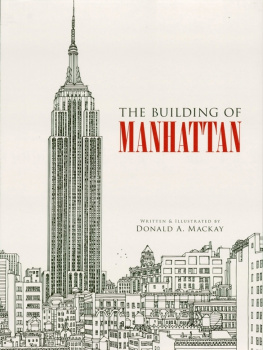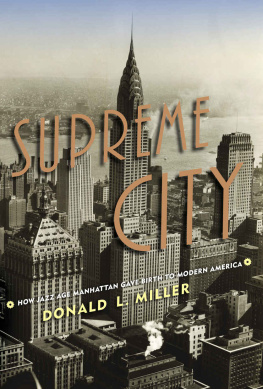Building the Skyline

Oxford University Press is a department of the University of Oxford. It furthers the Universitys objective of excellence in research, scholarship, and education by publishing worldwide. Oxford is a registered trade mark of Oxford University Press in the UK and certain other countries.
Published in the United States of America by Oxford University Press
198 Madison Avenue, New York, NY 10016, United States of America.
Jason M. Barr 2016
All rights reserved. No part of this publication may be reproduced, stored in a retrieval system, or transmitted, in any form or by any means, without the prior permission in writing of Oxford University Press, or as expressly permitted by law, by license, or under terms agreed with the appropriate reproduction rights organization. Inquiries concerning reproduction outside the scope of the above should be sent to the Rights Department, Oxford University Press, at the address above.
You must not circulate this work in any other form and you must impose this same condition on any acquirer.
Cataloging-in-Publication data is on file at the Library of Congress
ISBN 9780199344369
eISBN 9780199344383
To Kathy and Will
Contents
The writing of a book is seemingly a solitary task, but nothing could be further from the truth. This document is only the tip of a very deep iceberg. The restthe vast majority of itare the family, friends, colleagues, students, and organizations who have been so kind with their assistance and support throughout the years. Without them, I could never have completed this effort.
The seeds of this book came from two sources. First was from but her work carefully demonstrates that one cannot separate economics and architecture.
The second seed came in December 2005 when I stumbled on the website http://www.emporis.com/, which provides a data base of the vast majority of skyscrapers constructed throughout the world. With this data, I was able to explore my dual interestseconomics and New York City. As I reviewed the building information, a series of questions emerged. Specially, what were the determinants of skyscraper height in New York, and how did these determinants change over the course of the twentieth century? Unwittingly, these data launched me on a decade-long quest to understand something about New Yorks incredible history.
After I amassed a small body of academic publications that studied the economics of skyscrapers, I determined to put them together into book form. As I began to conceive of this project, it became clear that a book is not simply the sum of several articles. Academic articles have a very particular form. One that can be summarized as: (1) Research Question, (2) Related Works, (3) Theory and Model, (4) Data, (5) Results, and (6) Conclusions. Economists, as an academic breed, like to dispense with much of the historical and institutional context, and they simply want to see the question and results in as direct manner as possible. This is all well and good for a social science publication, but much of the interesting historical details had to be pushed aside. This book is thus my attempt to bridge the economics with the history. In particular, the first half of the book discusses the historical foundations for skyscrapers in New York and establishes the context for the economic analysis in the second part. It aims to fill in much of the details that were left out of my academic articles and to weave these papers into a more coherent narrative.
results of research performed specifically for this manuscript.
And now to the expressions of personal gratitude. I would first like to give a heartfelt thanks to Troy Tassier of Fordham University. If it were not for him, this book would not have been possible. As co-author, two of the chapters are based on research performed with him. No one can ask for a better collaborator and friend. I have been lucky to find someone who shares my interests in New York economic history, and working together has not only been productive but fun. He has enabled me to pursue this research agenda, and for that I am truly grateful.
I would also like that thank my other co-authors. Teddy Ort, as an undergraduate at Rutgers UniversityNewark, was incalculably helpful in assisting with the collection, processing,.
Many students at Rutgers UniversityNewark have provided valuable assistance. I am especially grateful to Nancy Elias, who tirelessly aided me in many ways. She proofread all the chapters multiple times and offered great comments, and she finished and edited the bibliography, which was originally begun by Kathleen Morales (a student at George Washington University). I thank Rubaa Saleh for her efforts with collecting and creating the images for this book. Eon Kim has also been helpful in several ways. She helped with geo-processing and geocoding historical data (including creating an address locator for 1852), and she has done an excellent job producing the maps in the book.
Other students have helped me collect data over the years. Everet Rummel and Robert Utzinger have been excellent research assistants, as have Sher Singh and Froozan Makhdoom. The students in my Fall 2014 Honors Social Science Seminar diligently worked on the map as well. Together, they have, for the first time, brought a view of Manhattans rock floor to the public at large.
. Although they have all been so kind with sharing their wisdom, any errors in the book belong to me and me alone.
I also appreciate the comments and feedback from attendees at various seminars and conferences. I thank participants from seminars at Binghamton University, CUNY Queens, Emory University, Fordham University, Hunter College, Lafayette College, and New York University. I am especially grateful to have been able to present my work to the Columbia University Economic History Seminar, and I have appreciated the opportunity to talk with the members of the group over the years, particularly Alan Dye and Gergo Baics. My work has also benefited from presentations at several conferences including the American Economic Association Meetings, the Eastern Economic Association Meetings, and the Southern Economic Association Meetings.
Several libraries and institutions proved vital. Columbia Universitys Avery Library contains a wealth of information on New York real estate. I thank Carol Willis and the Skyscraper Museum for providing valuable data. Without the Internet, I do not think I could have written this book. Several websites have been key, including http://emporis.com and http://skyscraperpage.com, which contains a wealth of information about skyscrapers.
I would also like to thank Rutgers UniversityNewark. My colleagues in the Economics Department have been very supportive throughout the years, especially Peter Loeb, who, as chair, hired me as an assistant professor in 2003. RutgersNewark provided a wonderful academic climate and allowed me the luxury to merge my professional and personal interests by writing this book. Much of the research in the second part of the book was partially funded by Rutgers University Research Council Grants, which have been immensely helpful and appreciated.
I also thank my colleagues Alan Sadovnik and Robert Snyder for their advice over the years. I thank my co-authors on other related works, including Jeffrey Cohen, Bruce Mizrach, and Kusum Mundra. For general moral support and friendship I thank Francesco Passarelli, Francesco Saraceno, Regan Solmo, Alexander Peterhansl, my mother, Marjorie Barr, and my sister, Stephanie Early. Bill and Ann OConnor and Mary Jean Hughes are wonderful in-laws, and have provided encouragement throughout the years. But, of course, this work would not have been possible with the patience and love of my wife, Kathy, and my son, William, and for this reason I dedicate the book to them.

